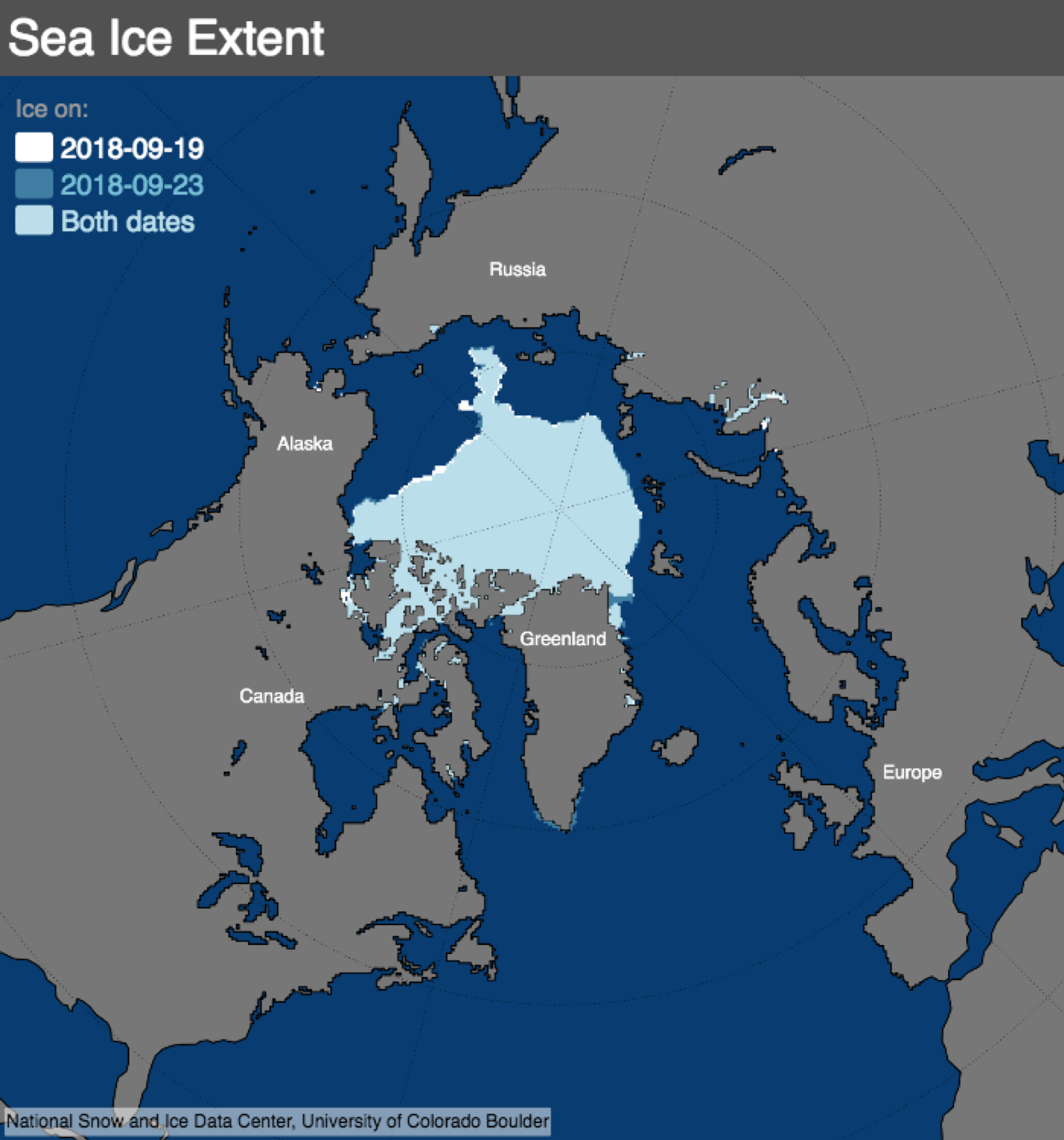Arctic sea ice hits sixth-lowest minimum in satellite record
The ice also reached its annual on two separate dates and was later than usual.
After six months of seasonal thaw, Arctic sea ice has reached what appears to be its annual minimum, settling at the sixth lowest extent in the satellite record, according to the National Snow and Ice Data Center.
Sea ice extent — the area in which there is at least 15 percent ice coverage on the water — fell to 4.59 million square kilometers (1.77 million square miles) on Sept. 19 and 23, the center reported on Thursday. That puts the 2018 minimum in a near-tie with 2008 and 2010. Though this year’s minimum was well above the record-low 3.39 million-square-kilometer (1.31 million-square-mile) minimum extent reached in 2012, it is part of a clear pattern: The 12 lowest sea ice minimums in the satellite record have all been in the past 12 years.

The minimum announcement is preliminary because “changing winds could still push the ice extent lower,” the NSIDC said.
The Sept. 23 date for minimum ice extent is one of the latest in the four decades of satellite records, the NSIDC said. Usually, the minimum extent is hit in mid-September. “The lateness of the minimum appears to be at least partially caused by southerly winds from the East Siberian Sea, which brought warm air into the region and prevented ice from drifting or growing southward,” the NSIDC said in its announcement.
Although a tie spot for the sixth-lowest minimum might not seem remarkable, it continues a long-term downward trend documented over the satellite era, said NSIDC director Mark Serreze.
“We are not seeing any kind of a recovery here,” he said. Because of short-term weather variation, the ice minimum has been bouncing around year to year, but there is an overall trend and 2018 remains right on that trend line, he said.
“Things are warming up. We’re losing sea ice, but also there’s a lot of variability in it,” he said.
The 2018 melt season followed a near-record low winter maximum that might have set up a drastic loss of sea ice. It is part of a pattern over recent years of unusual winter warmth and slowed freeze-up.
Instead, some cool summer weather — particularly in July, which is usually the biggest melt month — tempered the melt, Serreze said. “August was actually warmer than July for the Arctic Ocean as a whole, which is rather unusual,” he said.
Also unusual was the way the apparent minimum occurred. Ice extent was bottomed out over several days, Serreze said, ultimately producing two separate dates for the year’s lowest levels.
Through the summer and fall, the melt season followed a bumpy pattern and was patchy, with ice lingering in some regions and melt extending far north in other regions.
In the Beaufort Sea off northern Alaska and northwestern Canada, one detached patch of ice persisted into late summer, and the Northwest Passage sea route across the northern edge of Canada never fully opened.
But there was an unusual melt event — the emergence of a hole in the icepack north of Greenland, site of some of the Arctic’s oldest sea ice. The hole first appeared in February, part of a highly unusual winter melt across much of the Arctic. Though there was a winter re-freeze, the ice there was thin and vulnerable, according to NASA scientists. The combination of thin conditions and southerly winds caused the hole to re-open in summer, scientists said.
“This opening matters for several reasons; for starters, the newly exposed water absorbs sunlight and warms up the ocean, which affects how quickly sea ice will grow in the following autumn. It also affects the local ecosystem; for example, it impacts seal and polar bear populations that rely on thicker, snow-covered sea ice for denning and hunting,” Melinda Webster, a sea ice researcher with NASA’s Goddard Space Flight Center, said in a statement.
A more detailed analysis of the this year’s sea-ice melt will come in October, the NSIDC said.
Yereth Rosen is a 2018 Alicia Patterson Foundation fellow.